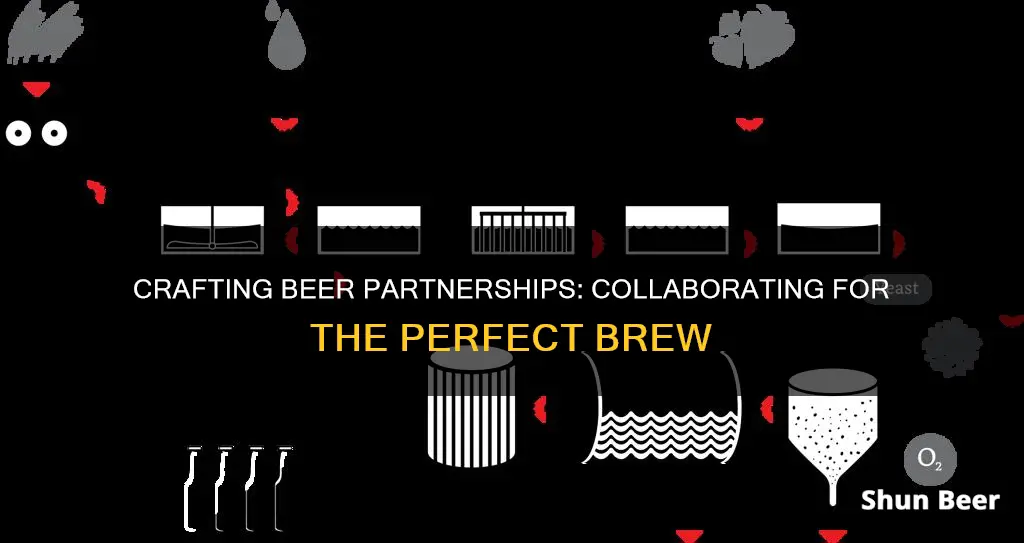
Beer collaborations are a way for breweries to spread their name into new markets or build hype around a beer release. Typically, two breweries will work together to produce a beer, though sometimes a brewery will work with a brand or company outside of the beer industry. The process usually starts with the brewers discussing the concept, name, and style of the beer, ensuring it reflects both brands and the value of the relationship. The beer is then brewed, canned, and released by one of the breweries, though sometimes both breweries will brew a beer as part of the collaboration. This is especially effective if the breweries are in different markets and are looking to build brand recognition.
| Characteristics | Values |
|---|---|
| Number of breweries involved | Usually two, but can be more |
| Type of collaboration | Brewery-brewery, brewery-brand/company, brewery-person/organisation/group |
| Creative freedom | High |
| Marketing potential | High |
| Beer type | Innovative, edgy concepts with unique or uncommon ingredients |
| Beer name | Reflects the brand and the value of the relationship |
| Beer production | One brewery takes the lead, but both contribute to the process |
| Beer distribution | One brewery takes the lead, but both benefit from the sales |
What You'll Learn
- The host brewery manages most responsibilities, including sourcing ingredients and brewing
- Visiting brewers can help with the cleanup and hop additions
- Collaboration beers are often born from a few beers being consumed
- The host brewery also handles packaging and label design
- The host brewery distributes and sells the beer

The host brewery manages most responsibilities, including sourcing ingredients and brewing
In a beer collaboration, there is usually a ""host" brewery that takes on most of the responsibilities, including sourcing ingredients, staffing the physical brewing of the beer, and sorting out packaging and label design. The host brewery will also be responsible for the raw material procurement, which includes grinding grain, mashing in, and transferring wort from the brew kettle to the fermenter. This can be a challenging process, as it requires a lot of equipment and resources. In some cases, the host brewery may even need to borrow equipment from another brewery to complete the collaboration.
The recipe for the collaboration beer is typically formulated beforehand as a group effort, either through in-person meetings or email communication. While the host brewery handles the majority of the brewing process, the visiting brewers will often take care of the cleanup and help with hop additions. It's important to note that the visiting brewers may have different expectations and levels of involvement, so clear communication and flexibility are key to a successful collaboration.
The host brewery also plays a crucial role in the marketing and distribution of the collaboration beer. By having both the host and visiting brewery's names on the product, it becomes a community-driven and marketing-savvy endeavor that can boost the cool factor and sales for both brands. However, navigating state and federal beer-shipping regulations can be tricky, so it's common for the beer to be distributed and sold through a single host brewery.
Overall, the host brewery plays a crucial role in the success of a beer collaboration, from sourcing ingredients and brewing the beer to handling packaging, marketing, and distribution. By working together and combining their creativity and resources, breweries can create unique and exciting beers that appeal to a wide range of beer enthusiasts.
Understanding Three-Burner Brewing: An Efficient Beer System
You may want to see also

Visiting brewers can help with the cleanup and hop additions
Beer collaborations are an effective way for breweries to spread their names into new markets or build hype around a beer release. They usually occur between two breweries, although sometimes a brewery will work with a brand/company that isn't a brewery, or with a person, organisation, or group.
When it comes to the brewing process, visiting brewers can help with the cleanup and hop additions. Hops are typically added to the wort in three stages during the boil: bittering, flavour, and aroma. However, not all beers will have three hop additions; some may have only one, while others may have up to five or six.
The timing of hop additions is crucial to achieving the desired flavour profile in the beer. The earlier the hops are added to the boil, the more bitterness they will contribute. For example, hops added during the first wort hopping stage will mainly impart bitterness to the beer. On the other hand, hops added during the last few minutes of the boil or at flame-out will contribute more aroma than bitterness.
Visiting brewers can assist with these hop additions, ensuring that the correct types and amounts of hops are added at the appropriate times. They can also help with the cleanup process, which is an important aspect of brewing to maintain sanitation and prevent off-flavours in the beer. By actively participating in the brewing process, visiting brewers can contribute their expertise and collaborate with the host brewery to create a unique and successful beer.
Morning Beer: Should You Drink Before Work?
You may want to see also

Collaboration beers are often born from a few beers being consumed
These friends often work at different breweries, so they each have access to different ingredients and equipment, which makes the innovative process of collaborating together both energizing and exciting. They will discuss the concept, name, style, etc., of the beer, ensuring it reflects their brands and the value of their relationship. Most collabs are a single beer brewed, canned, and released by one of the breweries, but in some cases, both breweries will brew a beer, which is especially effective if they are in different markets and are looking to build brand recognition.
The host brewery will take on most of the responsibilities for the brew day, including sourcing ingredients, staffing, and sorting out packaging and label design. The visiting brewers will often help with the cleanup and hop additions. On brew day, everyone acts as both students and teachers, and the team of brewers will often enjoy a few pints to celebrate.
Collaboration beers are usually innovative, edgy concepts that have never been tried before, often using unique or uncommon ingredients. When it comes to these beers, the more eccentric the idea, the more fun it is for brewers to make.
Pouring Beer: Understanding the Inner Workings of a Faucet
You may want to see also

The host brewery also handles packaging and label design
Packaging and label design are typically handled by the host brewery, which also takes on most of the responsibilities for the brew day. This includes sourcing ingredients, staffing the actual physical brewing of the beer, and sorting out the packaging and label design. The recipe is formulated beforehand as a group, either through in-person meetings or email chains. The host brewery team does the dirty work—grinding grain, mashing in, and transferring wort from the brew kettle to the fermenter—while the visiting brewers tend to start drinking almost immediately.
The host brewery is also responsible for raw material procurement, which can be challenging when it comes to exotic ingredients. It can be nearly impossible to source small batches of exotic fruits or vegetables for a brewing project, and these ingredients can be very expensive. For example, a local roaster took three months to squirrel away enough roasted beans for a coffee beer collaboration. Similarly, hops can be difficult to source, as breweries lock in their annual hop supply with contracts that are fulfilled in the year following the fall harvest. This can lead to substitutions or trades between breweries.
The host brewery will also handle the marketing of the collaboration beer, which is an important aspect of these projects. Collaboration beers are often marketed as limited releases, creating a sense of exclusivity and urgency for consumers. The involvement of multiple breweries or brands also brings together their respective fan bases and helps to get more eyes on and mouths around each brewer's products. Collaboration beers are an opportunity for breweries to spread their names into new markets or build hype around a beer release.
The Chemistry of Beer: How It Works and Why It Matters
You may want to see also

The host brewery distributes and sells the beer
When it comes to beer collaborations, the host brewery, or the one that owns the system and sells the beer, makes the rules. This means that the host brewery will take on most of the responsibilities for the brew day, including sourcing ingredients, staffing the actual physical brewing of the beer, and sorting out packaging and label design. The host brewery will also be the one to sell the beer and make the final call on the product.
The host brewery will also be in charge of scheduling the brew day, which will likely depend on the breweries' schedules and space. On brew day, the host brewery will be responsible for grinding the grain, mashing in, and transferring the wort from the brew kettle to the fermenter. The visiting brewers will typically take care of the cleanup and will often help out with hop additions.
It is important to note that the host brewery will also benefit from the sales of the collaboration beer. In most cases, the collaboration beer will be brewed, canned, and released by one of the breweries, allowing them to generate revenue from the sales. This provides an opportunity for the host brewery to increase their sales and expand their brand reach.
Overall, the host brewery plays a crucial role in the collaboration process by taking the lead in the brewing and selling of the beer, while also reaping the benefits of increased sales and brand recognition.
Shout Stain Remover: Beer Stain Solution?
You may want to see also
Frequently asked questions
Collaboration beers are made when two or more parties, usually breweries, work together to produce a beer. In some cases, both breweries will brew a beer as part of the collaboration, allowing them to build brand recognition in different markets.
Collaborations usually start because people in the brewery industry are well connected to each other. Many move from brewery to brewery and enjoy connecting with others in the community. These connections often lead to friendships, and friends decide to brew a beer together.
There is usually a \"host\" brewery that takes on most of the responsibilities for the brew day, including sourcing ingredients and staffing. The visiting brewer or brewers will often take care of the cleanup and help out with hop additions.
Beer collaborations allow brewers to experiment and be creative, try out new ideas and ingredients, and learn from each other. They also provide an opportunity to get more eyes on and mouths around each brewer's products, boosting sales and brand recognition.







